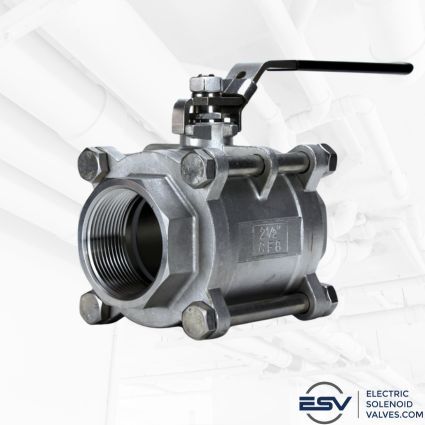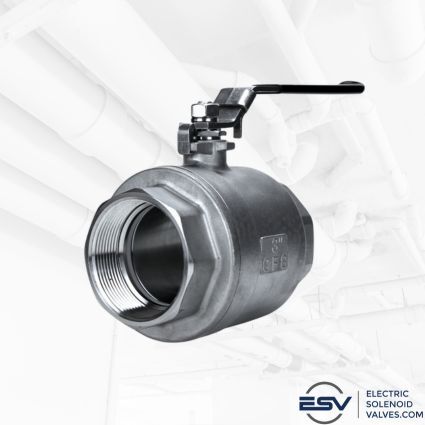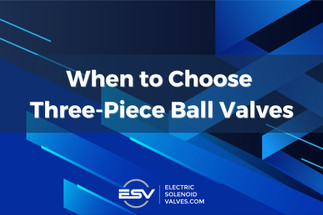Feb 6th 2025
When to Choose Three-Piece Ball Valves
If you work with fluid systems, you know that maintenance downtime can be costly. It leads to lost productivity and more labor and replacement costs. That’s why industries like food processing, pharmaceuticals, and chemical manufacturing rely on 3-piece ball valves.
3-piece ball valves make cleaning, repairs, and replacements significantly easier. Does that mean they’re always the best choice? Not necessarily. In this guide, we’ll break down when it makes sense to invest in a 3-piece ball valve and when a simpler design might do the job just as well.
I. Overview of Ball Valve Designs
Ball valves come in various designs, each with its own set of advantages and challenges. The most common designs include:
-
One Piece Ball Valves: These have a single, solid body, making them the most compact and cost-effective option. However, because they cannot be disassembled, maintenance requires full replacement, making them less ideal for applications requiring frequent servicing.
-
Two Piece Ball Valves: Typically consist of two main body sections, offering a balance between affordability and serviceability. While they allow for some internal access, they often require full removal from the pipeline for repairs or replacements
-
Three Piece Ball Valves: Feature a split body design that separates the valve into three segments, allowing for easier maintenance and repair.
II. Advantages of Three Piece Ball Valves
 A three-piece ball valve consists of three main components: a central body that houses the ball, stem, and seats, and two end caps that connect to the pipeline. The key advantage of this design is the valves’ ability to be dismantled without disturbing the pipeline or disconnecting the piping. Unlike 1-piece or 2-piece valves, which often necessitate disconnecting entire sections of piping, 3-piece ball valves allow for in-line disassembly. This means the central housing containing the ball and seals can be removed while the end connections remain attached to the piping on either side.
A three-piece ball valve consists of three main components: a central body that houses the ball, stem, and seats, and two end caps that connect to the pipeline. The key advantage of this design is the valves’ ability to be dismantled without disturbing the pipeline or disconnecting the piping. Unlike 1-piece or 2-piece valves, which often necessitate disconnecting entire sections of piping, 3-piece ball valves allow for in-line disassembly. This means the central housing containing the ball and seals can be removed while the end connections remain attached to the piping on either side.
This leads to several distinct benefits:
-
Ease of Maintenance: This is the biggest advantage. The body of the valve can be easily removed from the pipeline without disturbing the piping connections. This allows for:
-
In-line maintenance: Seals, seats, and even the ball itself can be inspected, cleaned, repaired, or replaced without having to cut into the pipeline.
-
Quick component replacement: If a part fails, it can be swapped out quickly, getting the system back online faster.
-
Easy cleaning: The body can be removed for thorough cleaning, which is especially important for applications involving viscous fluids or those prone to leaving residue.
-
Reduced Downtime: Because maintenance is so much easier, the overall downtime for repairs is significantly reduced.
-
Cost-Effectiveness in the Long Run: While 3-piece ball valves typically have a higher initial cost than 2-piece valves, the ease of maintenance and reduced downtime often result in lower total cost of ownership over the valve's lifespan. The savings in labor and reduced production losses often outweigh the initial price difference.
-
Reduced Risk of Leaks: Because the end connections remain undisturbed during maintenance, there's less chance of creating new leaks at those connections compared to a 2-piece valve where you'd have to disconnect the piping.
III. Drawbacks of Three Piece Ball Valves
Despite their advantages, three piece ball valves come with potential drawbacks:
-
Higher Initial Cost: The complexity of the design can lead to higher manufacturing and purchase costs compared to two-piece valves.
-
Potential for Leakage: More joints and seals increase the risk of leaks if the components are not maintained properly. Regular inspections and proper assembly are critical to mitigate this issue.
-
Complex Assembly Requirements: The increased number of parts requires precise assembly. Incorrect installation or improper reassembly during maintenance can compromise the valve’s performance and durability.
-
Larger Size: The modular design usually results in a bulkier valve. In installations where space is limited, this larger footprint might pose a challenge.
IV. When to Choose a Three Piece Ball Valve
You should choose a 3-piece ball valve when the following factors are important:
-
Frequent Maintenance: If you anticipate needing to clean, inspect, or replace internal components of the valve regularly, a 3-piece valve is the best choice. This is common in industries like food and beverage, pharmaceuticals, chemical processing, and any application where contamination or wear is a concern.
-
Reduced Downtime: When process interruptions are costly, a 3-piece valve is essential. The ability to service the valve without disconnecting it from the pipeline minimizes downtime and keeps production running.
-
Long-Term Cost Savings: While the initial cost is higher, the ease of maintenance and reduced downtime often lead to lower total cost of ownership over the valve's lifespan. The savings in labor and minimized production losses can offset the initial price difference.
-
Complex Installation Requirements: When space is limited or the system design complicates complete valve removal, the three piece configuration permits partial disassembly. This feature is especially valuable in retrofit projects or installations where accessibility is a challenge.
-
Critical Applications: Where minimizing downtime is crucial, the in-line maintenance capability of a three-piece valve is highly advantageous.
Here are some specific examples of situations where 3-piece ball valves are often preferred:
-
Food and Beverage: Frequent cleaning is essential for sanitary reasons.
-
Pharmaceuticals: High purity and ease of sterilization are critical.
-
Chemical Processing: Handling corrosive or hazardous materials often requires regular inspection and maintenance.
-
Oil and Gas: Remote locations or harsh environments may make in-line maintenance preferable.
-
Manufacturing: Reduced downtime in production lines minimizes costly interruptions and maximizes output.
When You Don’t Need a Three Piece Ball Valve
 While three piece ball valves excel in applications that require frequent maintenance and reduced downtime, they might not be the best option in the following scenarios:
While three piece ball valves excel in applications that require frequent maintenance and reduced downtime, they might not be the best option in the following scenarios:
-
Minimal Maintenance Requirements: If your system rarely needs cleaning or component replacement, the added complexity and cost of a three piece valve may be unnecessary. A simpler valve design can be more cost-effective in low-maintenance environments.
-
Budget Constraints: The higher initial investment for a three piece valve may not be justifiable for projects with strict upfront cost limitations. In applications where maintenance needs are minimal, opting for a less expensive valve option can help manage budget constraints.
-
Compact Installations: Three piece valves typically have a larger footprint due to their segmented design. In situations where space is at a premium, a single or two piece valve might be a better fit without compromising functionality.
-
Low Downtime Impact: If temporary process interruptions do not significantly affect overall operations or profitability, the benefit of reduced downtime provided by a three piece design may be less critical. In these cases, simpler valve types can suffice.
V. Factors to Consider When Selecting a Valve
If you determine that a three piece ball valve is the right choice, consider the following when choosing the right valve for your system:
-
Operating Pressure and Temperature Ratings: Make sure the valve is designed to handle the specific pressures and temperatures in your system. A mismatch can lead to premature failure or unsafe operating conditions.
-
Fluid Type and Chemical Compatibility: The valve material must be compatible with the fluids it controls. Consider chemical reactivity, viscosity, and the presence of particulates, which could affect seal integrity and overall valve performance.
-
Installation Space and System Design: Evaluate the physical footprint and accessibility within your system. Three piece valves offer modularity, but you should check to make sure the design aligns with your installation constraints and supports easy maintenance.
-
Lifecycle Cost Analysis and Maintenance Frequency: Although three piece valves might have a higher initial cost, their ease of maintenance can lead to long-term savings. Analyze the total cost of ownership by considering factors such as expected maintenance intervals, repair costs, and the potential for reduced downtime.
VII. Conclusion
Choosing the right ball valve for your system is essential for optimizing performance, minimizing downtime, and controlling long-term costs. While three-piece ball valves offer unmatched ease of maintenance, flexibility, and cost savings over time, they may not be necessary for every application. If your system requires frequent servicing, handles critical fluids, or operates in a high-purity environment, investing in a three-piece design is a smart decision. However, for low-maintenance or budget-conscious applications, a one- or two-piece ball valve might be a better fit.
Still unsure which valve is best for your system? Explore our full selection of manual ball valves or contact our valve experts for personalized recommendations. We’ll help you find the perfect solution to maximize efficiency and reliability in your operation. Shop Three-Piece Ball Valves Now or Talk to an Expert.

